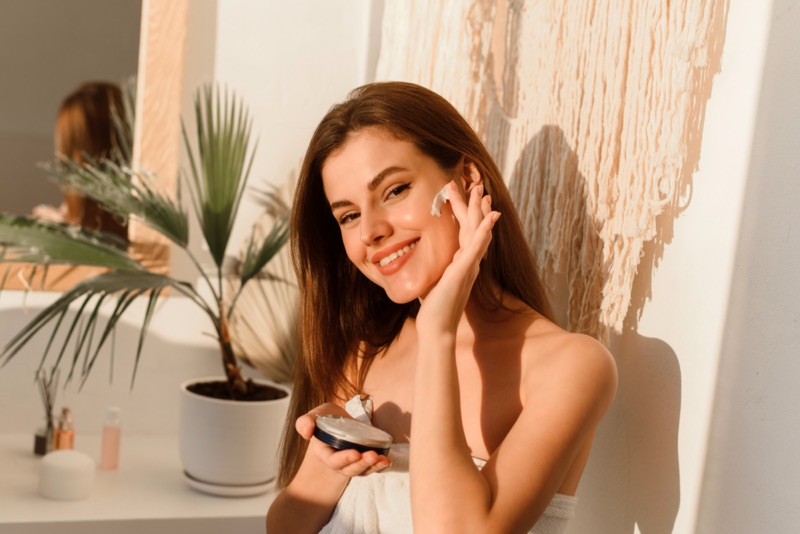Retinol and Hyaluronic Acid are one of the most popular and searched-for ingredients in the skincare industry and why wouldn’t they be?
Know all their outstanding benefits for skin, and how to use them correctly to get the maximum benefits of the ingredients.

Can you use Hyaluronic acid and Retinol together at the same time?
How to use both Hyaluronic acid and Retinol together in your skincare routine
- Wash your face with a fragrance-free gentle cleanser.
- Pat the skin dry completely with a facial tissue or a clean towel.
- Put a few drops of Hyaluronic acid first to offset any irritation. Massage it nicely with light circular strokes.
- Use a pea-sized amount of retinol cream or retinol serum. Massage it evenly on your face and neck taking care of the eyes and mouth areas. As a tip, you can also use some Vaseline before applying retinol on those corner areas for extra protection.
- Layer it with a non-comedogenic moisturizer.
- Never forget to put sunscreen on at the end.
Hyaluronic Acid
It’s a Blessing for all skin types especially, Dry skin types. Hyaluronic Acid is a humectant that basically pulls moisture onto the surface from within the layers of the skin giving a plumping effect to the skin. It hydrates the skin keeping the lipid barrier strong which means, no loss of moisture from the skin(epidermis) resulting in healthy, youthful, and glowing skin.
How to use Hyaluronic acid serum in your skincare routine
- Always layer Hyaluronic acid with a moisturizer and seal the skin, if you don’t and if the air around you is dry, hyaluronic acid will make the skin drier by pulling up all the moisture from deep layers of your skin and leaving the skin uncomfortably tight. So don’t forget the moisturizer.
- When using Hyaluronic Acid with other ingredients or acids, always use hyaluronic acid as the last serum before the moisturizer followed by sunscreen.
- Apply Hyaluronic Acid on clean damp skin, it absorbs amazingly well on damp skin.
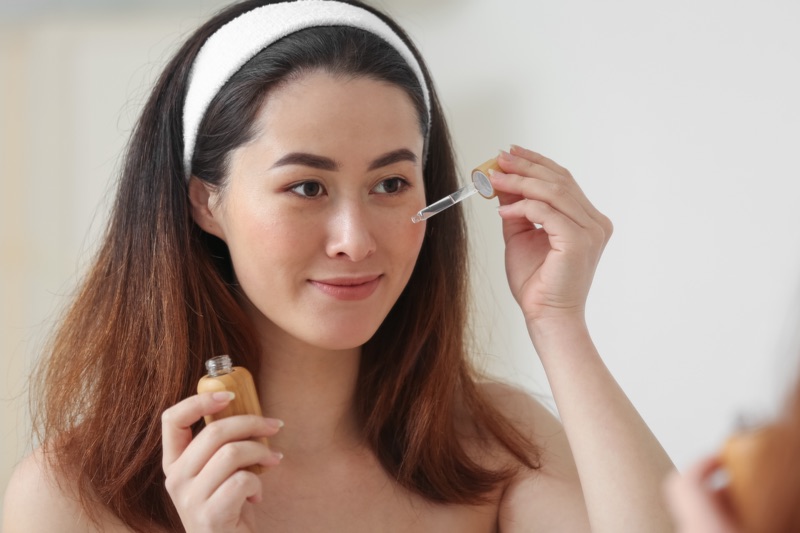
Which other ingredients is Hyaluronic acid compatible with?
Retinol
Here comes the Star Ingredient!! In the beauty industry, there is no substance more googled, loved, praised & misunderstood than Retinol. ha-ha.
Retinol, in very simple words, slows down skin aging and treats stubborn acne YES! Stick till the end to master the ingredient and combat most skin concerns.
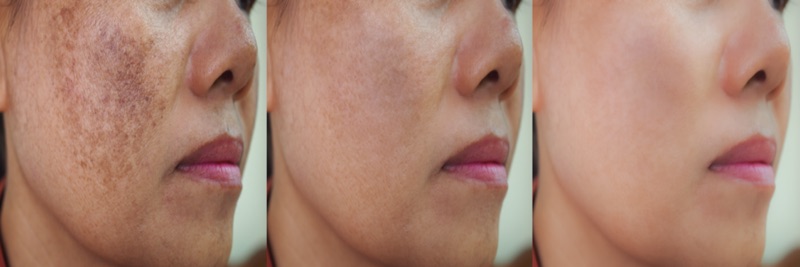
First, the scientific perspective of Retinol, just the basics I promise.
So, Retinol is a derivative of Vitamin A (God for skin) that gets converted by skin enzymes into Retinoic acid. Retinol is often confused with Retinoid (also a derivative of vitamin A) but Retinol has a lower percentage of Retinoic acid (that’s why Mild/Less potent) than Retinoid hence Retinol is easily available over the counter, while Retinoid needs a prescription. Because their percentage of Retinoic acid is lower, Retinol also works slowly, yet is quite effective in
- Boosting Collagen production by speeding skin cell turnover rate to double which results in even skin tone, younger and firm skin texture.
- Treating acne and acne lesions.
- Retinol is an anti-aging ingredient that reduces the appearance of fine lines, wrinkles, sun damage, sagging skin and helps with hyperpigmentation.
How to incorporate Retinol into your skincare routine safely

- Always wear sunscreen with SPF 30-50 when you’re out during the day. Using Retinol makes your skin highly photosensitive which means the skin is very sensitive to UV rays.
- Use Retinol only at Night.
- Do not mix Retinol with any other ingredient except the ones mentioned in the article.
- Do not use it very close to your eyes, mouth, or nose.
- For sensitive skin types and beginners, always start with the lowest concentration, like .25%, and gradually increase the percentage to 1.
- Never exceed the quantity of more than a pea size. Too much does more harm than good.
- Do not forget to use it on the neck as well.
- Don’t forget to layer it with a non-comedogenic moisturizer followed by sunscreen.
- Start with using Retinol twice a week and then gradually increase to every other night.
- Try and avoid using other acids or chemical exfoliants in your skincare routine when you’re beginning your Retinol journey. This can minimize your excess flaking or chances of over-exfoliation.
How to handle any Retinol side effects or allergic reactions?
- Take cold showers or ice your face (wrapped in a thin cloth). Avoid hot showers at any cost.
- Avoid using cleansers or moisturizers with fragrances, alcohol, or sulfates.
- Use Thermal spring water to calm the skin (Try from La Roche Posay)
- Don’t use any exfoliating fancy gadgets to wash your face, simply hands.
- Give a lot of moisture and hydration to your annoying dry skin for it to feel better. Apply moisturizers loaded with Ceramides (Helps in skin barrier), Hyaluronic acid, and Oatmeal.
- Now, seal the skin with a light layer of Vaseline (‘Cereve healing solution‘). It locks in all the goodies we’ve given and lets the skin heal faster.
- Stop using any other exfoliants, acids, AHAs, BHAs, peroxides, salicylic acid, or chemical peels until you are completely healed.
- Cica Balms, Shea butter, Glycerin, and Aloe vera, are great soothing and calming ingredients for irritated skin.
- Product suggestion- Try Avene- Cicalfate + restorative protective cream.
- Apply sunblock before stepping outside. Remember your skin is already in a vulnerable state. UV rays at this point can make it worse.
- All the reactions are temporary, so don’t freak out, your skin will be back to its original state with these precautions.
Who should not use Retinol?
- If you’re trying for pregnancy, are pregnant, or are breastfeeding. DO NOT use retinol. Instead, in pregnancy use, the ingredients that are recommended here.
- People with skin conditions like Rosacea and Eczema, unfortunately, shouldn’t use Retinol. It can make dry skin worse.
How much time Retinol serum takes to work on the skin?
It may take up to 4-12 weeks to produce noticeable results so be patient & enjoy the retinol journey and bear with the Retinol purge phase.
Which other ingredients is Retinol compatible with?
- Niacinamide
- Hyaluronic acid
- Azelaic Acid
How does Retinol work on your skin?
- When we start to age, our cells don’t regenerate as quickly as they did when we were young.
- Retinol directly affects gene expression, regulating all our age-related issues by eliminating dead skin cells and allowing fresh, young skin cells to come up to the surface.
- It goes deep into the layers of the skin and exfoliates it from within. It also clears up acne by cleaning up the pores and eliminating bacterial growth.
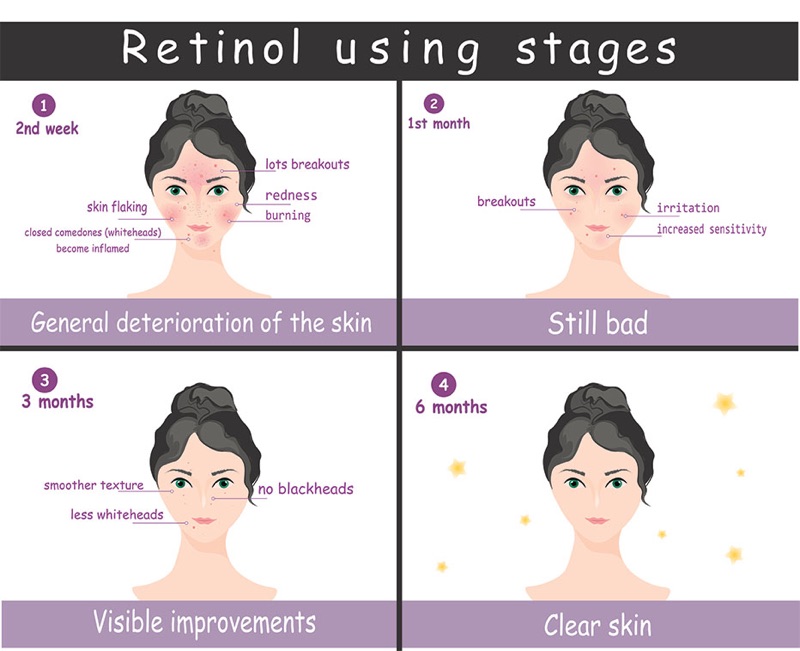
Retinol is not a very stable ingredient in nature & perhaps they like staying in cool, dark places. Quite away from Sunlight, (almost like a vampire LOL) to extend & maintain its shelf life.
Retinol Family Tree!!
Retinoid is the head of the family with its 7 children (with recommended percentage).
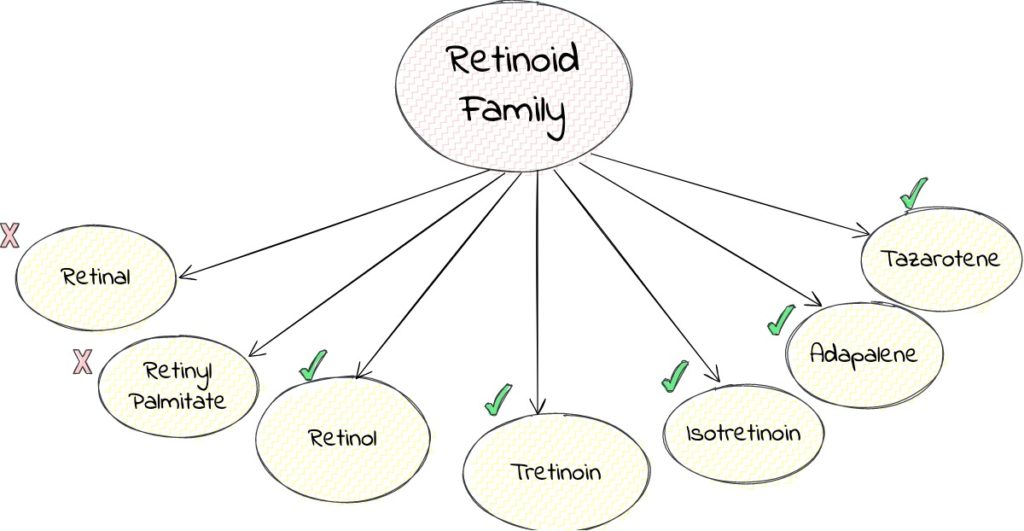
- Retinol (the most popular child)-0.1% – 1.0%
- Retinyl palmitate (it’s almost pointless so don’t even bother)- 1%
- Retinal (not easy to find in products because of serious stability issues but an alternative to retinol if you’re looking for something with more efficacy)-0.1%-1.0%
- Retinoic Acid or Retin-A (Gold standard retinoid, very commonly given as Tretinoin by doctors for treating mature skin issues. 20 times more powerful than Retinol. Only available by prescription)-0.01-0.1%
- Adapalene (Can get over the Counter. Solid effective in treating acne)-0.1%
- Tazarotene (Used for Hyperpigmentation & acne scars. Only available by prescription)-0.1%
- Isotretinoin (Oral retinoid you can say. It’s used to treat severe cystic acne).

Conclusion-Hyaluronic acid and Retinol
- If you are looking for something to treat your acne and fight premature skin aging signs, go for Retinol.
- If you are looking for something which can calm your skin and make it dewy and plump go for Hyaluronic Acid.
- Combining Hyaluronic acid and Retinol together is a double dose of happiness for the skin. Any potential dryness or irritation caused by Retinol can be combated by applying Hyaluronic acid as the first layer on the skin.
References
Related articles you may like:
- Can you use Glycolic Acid with Retinol?
- Should you apply Retinol before or After Moisturizer
- Can you use Benzoyl Peroxide with Retinol?
- Can you use Azelaic Acid and Retinol Together
- Can you use Vitamin C with Retinol?
- Can you use Niacinamide with Retinol?
- Can you use Salicylic Acid and Retinol Together?
After reading the whole thing, you’ll not make the mistakes I made.
Love~ Beauty Stroll
